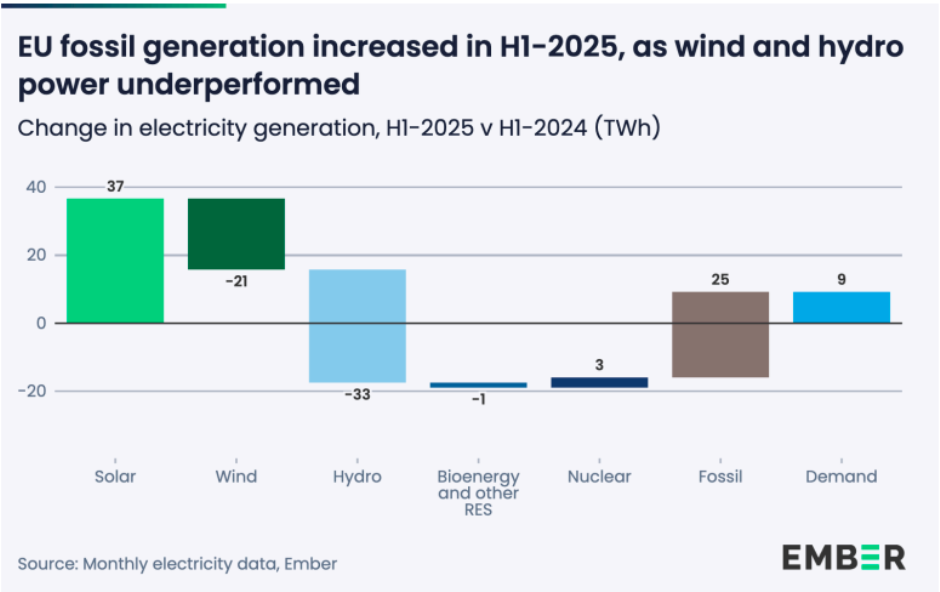The European Union generated 8.8 percent (1,303 TWh) of global electricity demand and accounted for 4 percent (293 MtCO₂) of the world’s power sector emissions in the first half of 2025. Despite strong growth in solar power, unfavorable weather conditions for wind and hydro reduced renewable output overall, leading to higher gas generation and a rise in emissions across the bloc.
Modest Electricity Demand Growth Continues
Electricity demand in the EU increased slightly by 9 TWh (0.7 percent) in the first half of 2025, following a similar rise of 14 TWh (1.1 percent) during the same period in 2024. This marks the second consecutive year of subdued demand growth after two years of decline driven by high energy prices and the COVID-19 pandemic’s impact on industrial output, according to new analysis from Ember.
While demand has started to recover, growth remains moderate as European industries continue to rebuild capacity amid economic uncertainty and fluctuating energy costs. Analysts expect demand to rise gradually through 2025, supported by the electrification of transport and heating sectors.
Solar Expansion Outpaces Demand, but Wind and Hydro Decline
Solar energy generation was a bright spot for the EU energy mix, growing by 37 TWh (24 percent) in H1 2025 — up from a 26 TWh (21 percent) rise last year. This boosted solar’s share of total electricity generation to 14 percent, compared to 12 percent in H1 2024. Notably, June 2025 saw solar become the single largest electricity source in the EU, contributing 22 percent of total generation, according to Ember.
However, poor weather conditions hindered wind and hydro output. Wind generation fell by 21 TWh (8.5 percent), reversing the 21 TWh (9.3 percent) increase recorded last year, and reducing its share in the electricity mix to 17 percent, down from 19 percent. Unfavorable wind patterns between January and April were the main cause of the decline.
Hydropower output also plunged by 33 TWh (17 percent), compared to a 34 TWh (21 percent) increase in H1 2024. Droughts and heatwaves across southern Europe reduced water availability, cutting hydro’s share to 12 percent, from 15 percent a year earlier.
Bioenergy generation slipped by 1.7 TWh (3.2 percent), continuing a mild downward trend seen in 2024, while nuclear power increased modestly by 3 TWh (1 percent), maintaining a stable share of 23.5 percent in the EU’s electricity mix.
Fossil Fuel Generation and Emissions on the Rise
The combined decline in wind and hydro power forced the EU to rely more heavily on fossil fuels to meet electricity demand. Gas-fired generation rose by 25 TWh (14 percent), reversing last year’s 29 TWh (14 percent) decline, increasing its share in the electricity mix to 16 percent from 14 percent in 2024.
Coal generation remained nearly flat but saw a small increase of 1.4 TWh (1.1 percent), maintaining its 9.7 percent share of total electricity production. This contrasts with the sharp 39 TWh (24 percent) fall in H1 2024, when coal use dropped significantly amid record renewable output. Other fossil sources fell slightly by 1.1 TWh (3 percent), trimming their share from 2.7 percent to 2.6 percent.
As a result, the EU’s power sector CO₂ emissions rose by 13 MtCO₂ (4.8 percent) in the first half of 2025 — a setback for the bloc’s climate goals following notable declines in 2023 and 2024.
Balancing Energy Security and Climate Goals
The first half of 2025 highlights the challenges facing Europe’s renewable energy transition: while solar continues to grow strongly, variability in wind and hydro output underscores the need for more energy storage, grid flexibility, and diversification of renewable sources.
To meet its 2030 emissions reduction and renewable energy targets, the EU will need to accelerate investment in green infrastructure, expand cross-border energy integration, and enhance grid resilience to cope with climate-related disruptions.
Despite temporary setbacks, the continued rise in Solar energy generation and stable nuclear contribution suggest that Europe remains on track toward a cleaner, more resilient power system — provided that renewable deployment continues at scale.
Baburajan Kizhakedath

